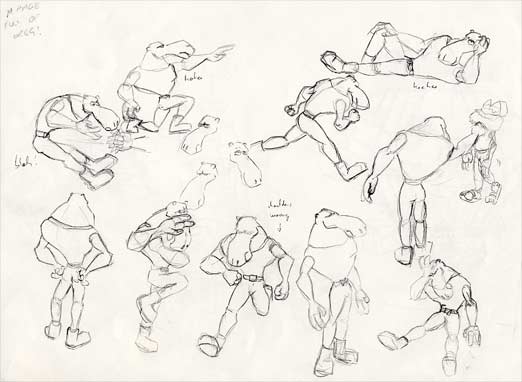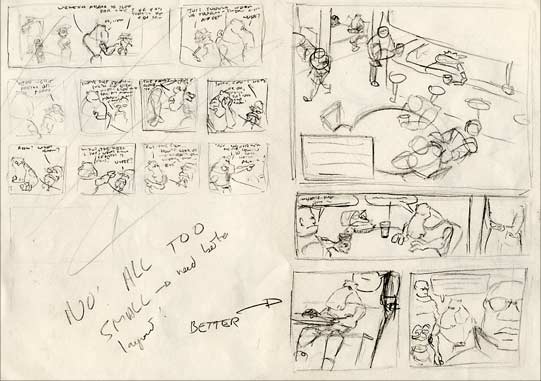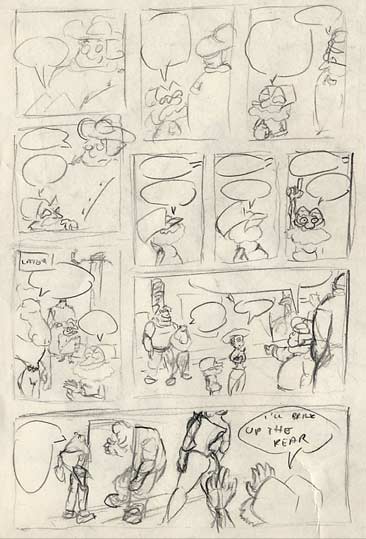THE DREGS OF WAR
mai|
|
Making the Comic Strip
DISCLAIMER: this page really goes on a bit. Make sure you are wearing protective clothing. Creating this comic strip has been an epic struggle against my inability to draw and my total ignorance about making comic books. There was quite a learning curve ahead of me, but luckily I was too stupid to care and wriggled my way up it, more or less, despite the incline. I had a concept, I had characters, I even had a plot. Some would argue that this is all you really need, but those people can draw. Annoyingly, I'm not one of those, apparently content to be only half-decent at drawing, lacking the drive to, well, draw all the time, which I hear is really quite important if you want to learn. In fact, drawing is quite funny like that. You think about it logically; surely, if you just concentrate, you could draw a face that doesn't make little children cry. You know what faces look like. Hell, you could just look in the mirror (though this is only valid if your face doesn't make little children cry) and have a look. So why is it, that upon confrontation with one of my creations, children consistently run out of the room screaming? Ok, that's not true, but I stand by my point. Drawing is one of those wonderfully revealing activities, which shines a light on just how crap your motor skills are, and how stupid you really are. We can all imagine a monster or person or superhero, we can see him standing majestically, cape flapping in the wind, looking towards the horizon, then you start drawing him, and run screaming out of the room. Observational drawing is something different. It's also really hard, and I'm bad at that too, but better than I am at drawing from imagination. I'm lucky that I went to an art school before joining the course, and was forced for hours to sit in front of things and draw them (drawing people, however, is really fun). Though I think this caused lasting, profound harm to my soul, it did teach me a lot about how to draw. But I can't be bothered to go into what I learned, because, well, it brings up memories of the horrible things the art teachers would make me do (namely, draw a lot) and I don't want to go back to that. So I suppose my point (yeah, I probably have one) is that I had to learn a lot of drawing skills to be able to do this comic (which is still badly drawn, though less likely to cause panic among readers). In an irritatingly obvious way, the best solution was to draw a lot, which requires patience and the bucket loads of confidence so that you don't break down and cry after your first few attempts. So I now have a sketchbook with lots of drawings of characters. This of course, is merely the tip of the iceberg. Most of my attempts were thrown away, so as to avoid causing unnecessary psychological harm to any who might come across my abominations. I also learned, that even though I thought I knew what I was trying to draw, a lot of the time I didn't. As in, I realised that my drawing improved a huge amount when I actually took the time to visualise exactly what I wanted to draw, right down to the smallest detail. This isn't as easy as it sounds. It seems that when I imagine a character, and how he or she looks, I'm thinking more of what effect the character has on the viewer, rather than what the character actually looks like. It takes a little more effort to do that. However, when I did, I tended to actually draw what I was thinking of. You can test whether you actually are thinking about what you're about to draw. One way is suddenly imagine the figure in silhouette- I often found that I wasn't sure what the silhouette was. Then think about relative sizes; how big is the torso compared to the legs (taking perspective etc. into account), that also I often hadn't properly thought of. Where, exactly, are the arms? What position are the fingers in? In fact, I rarely got all these completely sorted in my head (it's only little), and had to hope they'd sort themselves out as I got to them. One thing I didn't get round to learning, was how to draw buildings and environments. In my defense, I find them really boring, and can't be bothered. That's why the comic strip has shitty environments. I'll learn them some other day. Back to the Comic Strip If you want to see one of the pages go through each of its stages, I've made a section on page 8 which does so... I still probably have a point, bear with me. I started designing the comic book last year (around February 2004), and actually did most of the work then. I designed all the characters (though Isabella was tricky, more on that some other time when I can be bothered to write about drawing women...).
Concept artwork for Dreg I started drawing little boxes and putting characters and text in them, supposedly designing the comic. But I was putting too many panels in each page, resulting in tiny drawings and boring page layout. I looked at the panel layout sketches, and realised that they simply didn't look like a comic book. Having come out of the comic-book reading geek closet, I can now say, with pride and confidence (and a desperate look in my eye), that I love comic books. I sort of knew deep in me what a comic book should look like. So I thought “Just trust your instincts”, then when that didn't work, I looked at lots of comic books, which was a much better approach. It immediately became apparent that panel layout was an art in itself, and that I was approaching it all wrong. Panel layout is actually really cool. No, really, it is! Being an animator, I've had to do a few storyboards in me time, which are quite fun, but aren't particularly exciting. There are two reasons for this. Storyboards have one major flaw; they're not animated. This is why I far prefer blocktests as preparatory work in animation. Storyboards are still vital, because you can make one much quicker than a blocktest, and you definitely want something to base your blocktest on, but still, you can't avoid the fact that the storyboard has very little resemblance to the final product, and is less satisfying to work on as a result. The other problem, which I didn't even know was a problem until working on the comic strip, is that in a storyboard you're restricted to a single aspect ratio. With a comic book, every image could have its own aspect ratio, which drastically changes the dynamic within the panel, and within the page. It also has much more semblance to the final product, and therefore feels more relevant. You could go from tall, thin aspect ratios to low, wide ones, to great big boxes, to tiny little things. You could stick panels within panels, and even more interestingly, characters don't need to be confined to a single panel, spilling out onto the others and interacting with them. Then you add speech bubbles, which can add to the complexity, ending in a dynamic, living page that the reader has to explore his or her way through... Of course, generally this means that the viewer can't read my comic, but on the pages that worked (I particularly like pages 3 and 5, for example) you end up with, well, what a comic book page should look like.
This is the point where I realised everything was going wrong! On the left hand side you can see, bassically, page 9 but taking up only half a page... to the right is page 1 redesigned! So I did that, 16 times, and had designed a comic book. In the panel layout sketches, I put speech bubbles in, but didn't write any text into them, thinking that I would remember what the text was supposed to be once I got to that point (surprisingly, I did, a year later). Though for particular, absolutely vital elements, I would write the text in to make sure I wouldn't forget.
A vital bit of text was inserted here to make sure I would not forget when it came to making page 4. Creating the Comic Strip But I stopped. I had a part time job, and was given a deluge of projects to do on the course (for some reasons, lecturers feel the need to let out all of their sadism on second year students) and quite simply did not have the time. Naturally, this annoyed me, having spent so much effort in designing this piece of work. So I decided that in the third year, I should seriously try to get it done. I decided (wisely) that the best way to do this was to somehow blag my way into making the comic strip one of my projects. There are three projects in the third year: the major project, which considering that this is a 3D animation course, tends to be an animation (or computer program), and besides, I was going to do the Dreg running around randomly film for that. Then there's the master class, where you are given a particular assignment, and have to do it (kind of like being given a job to do in the industry), so obviously that wasn't suitable. So we have the third project, the innovations project. As the name implies, this simply means you need to create something innovative. Well. Comic strips have been around for a while, so hardly innovative. But what about the reason for doing it? Well, there's an idea. There was the blag. It worked. So I had a project, and a reason to do it. Time to get it done. Over the Christmas holidays (2004), I penciled in each page on A2 sheets of paper. The most horrifically boring, annoying bit was drawing the panels. It's not fun worrying about keeping things parallel and all, especially on as big a format as A2. So I did all that first, then started drawing characters in the panels, which was considerably more fun. Though I didn't gather the courage to draw page 8 until later. Then I came back and had to worry about the masterclass. So for a while, progress was very slow, but I did manage to get all the drawings inked in. To achieve this, I used a funky brush pen thing, which has a brush instead of a nib, and looks cool. Even working on A2, though, left me with line art which is too thick. It seemed like such a good idea at the time... Anyway, now I had to find a way to get the A2 sheets into the computer. I had always figured that I'd just cross that bridge when I got to it. Well. It wasn't a fun experience. In fact, it deserves a title. Scanning in the pages In the end, I had to go to the “Open Access Centre”. The OAC is a large room full of mostly stone-age computers for the poor souls who aren't on our course, and therefore don't have access to the powerful machines we do. However, there are a couple of slightly more powerful computers (they actually have RAM) to use Photoshop on, and one monster size A3 scanner. The one problem with A3 scanners is that they're not big enough to scan A2 sheets of paper. But hey, I wasn't going to find a bigger one anywhere. So I started to scan the pages in, half a page at a time. At this point it was 15:00. 16 pages, so that's 32 scans. Ok... will take a while. But then I realised that these machines didn't have enough hard disk space for me to save the files I was scanning in (I admit they were huge). I could only save one file at a time. This meant that after scanning half a page in, I would have to save it to disk, then burn it to CD, then delete it. Naively I had only brought one CD with me, an RW 650MB (a shocking £2.10 at the Student Union Shop), having underestimated how stupidly big I would want these files by a factor of 3. So I slowly churned my way through a third of the comic strip, burning each file to CD as I went. Being an RW, the burning was relatively slow. It took about 4 minutes to burn a single file. So, 32 files, four minutes, lets say five to include scanning and saving etc. (it took about ten seconds just to save a damn file... admittedly a stupidly huge file- about 45MB per file when compressed), so that makes almost three hours. Fine. I'll be out at 18:00, hopefully. Eventually I filled the CD up, so I needed to get some more. I ran out at top speed, like some action hero, only with a lot less grace, and speed, and efficiency, and style, so that nobody would get the A3 scanner while I was away (I had cunningly set the computer to burn the last file to the CD, which I guessed would give me the time to buy the next CDs), I arrived panting at the shop, grabbed a couple of 700MB CD-Rs off the shelf, growled at a girl who was considering getting into the queue before me, then purchased them (at a shocking 80p each). I went back, and continued scanning in files, saving one to disk, burning to CD, deleting from disk... with the CD-Rs, the process was considerably quicker, and I thought I might actually be finished by 17:00. Ok, now considering the work flow, or more particularly, the fact that i deleted the files from hard disk after burning them to CD (as well as, perhaps foolishly, closing them within Photoshop... I just didn't trust the computer enough to handle keeping all those large files open), what could be the worst thing that could happen? Yeah, it would really suck, wouldn't it, if just as you were getting near the end of the CD, it should screw up, get corrupted, and stop working. Imagine that you'd spent the last hour working on this, and suddenly all the files that you'd been burning to this crappy CD were to be lost, in one foul swoop. As in, the entire operating system would freeze if you put this CD into the drive. Yeah, that would suck. Well, suck it did when it happened to me. I was quite annoyed, really. I threw the CD into the bin with an elaborate flourish, and a dark, stormy look I hoped would impress the very attractive foreign girl sitting next to me. I grumbled a bit, put the second CD in, then started to re-scan all the pages I had just done. That's when I really started to feel bored. I tried to chat up the attractive foreign girl, but she wasn't having any of it (this is when I decided the goatee just had to go), and I had to resort to reading the Guardian as the files got burnt to CD. But I felt I could hang on, just about, so long as the CD didn't screw up again. Yeah, well, it did. Two CD-RWs (an extortionate £4.20) and several hours later, I finished scanning in all the files, and emerged from the OAC into the night air, a broken shell of a man. When I got home, Adam greeted me with a smile and a warm hug, to which I reacted by getting him into an arm lock and beating him repeatedly with a metal pole until he lost consciousness. Then I left him naked in the middle of a busy road. This didn't put a crimp on our relationship, because once he got home Adam cooked me a meal and gave me a foot rub so as to say sorry for not being more aware of my mood before greeting me. In any case, I had the files in computer now. Total time taken: seven hours. Money spent: £7.30. Colouring in the comic I stitched the half-pages together, then added the text. That was stupidly fun, and it suddenly gave the characters life. They had “voices” and a story was being told. Now came the real challenge colouring in the comic. Well. I tackled the first page, not very sure of what to do. I played around with it a lot, trying to get the sense of light and dark which is important for the world, and slowly got to a style that I liked, but which didn't take huge amounts of time to do (I had about a week to colour all the pages in). Even so, I had to spend about five hours per page for colouring in (though this was reduced to three hours per page by the end of the week). I did the backgrounds in Photoshop, using the stylus' ability to interpolate between the foreground colour and the background colour depending on the pen's pressure, thereby allowing me “paint” light and dark really quickly. Though the sort of gradient effect looks just a little tacky... but in the time I had it was the best I could do. Then I did the characters in Painter. For me to go into more depth about colouring the comic, I think I'll need another page...
|
©Michael Beeson 2004


